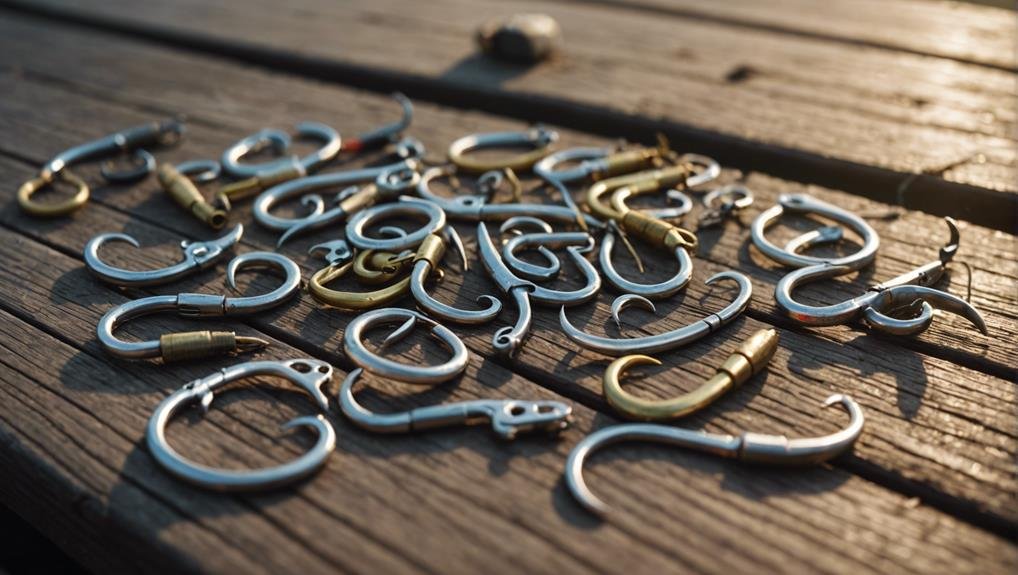You might think choosing the right fishing hook size is straightforward, but there’s more to it than meets the eye. Different sizes, ranging from tiny size 32 to massive 19/0, can significantly impact your catch rate. It’s not just about the fish’s mouth size; factors like bait type and water conditions matter, too. Have you ever wondered why certain hooks work better in freshwater than saltwater? Or how do some anglers always seem to pick the perfect size? Discover the nuances that could make your next fishing trip successful.
Key Takeaways
- Hook sizes range from size 32 (smallest) to 19/0 (largest), with larger numbers indicating smaller hooks.
- Freshwater hooks range from size 32 to 1, ideal for species like panfish, bluegill, and trout.
- Saltwater hooks range from size 12 to 19/0, suited for various marine species, with circle hooks great for catch and release.
- Choosing the correct hook size depends on the target fish’s mouth size and the bait used.
- Regular maintenance, including rinsing and sharpening hooks, extends their lifespan and ensures optimal performance.
How Hook Sizes Work
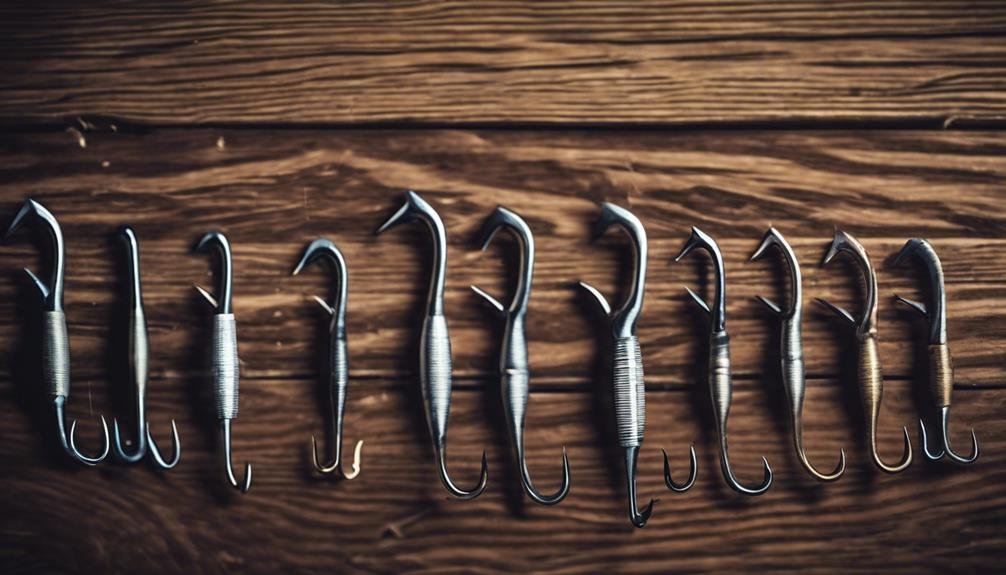
Understanding how hook sizes work is essential for selecting the right one for your fishing needs. Fishing hooks come in various sizes, indicated by numbers or aughts. It’s important to grasp that larger numbers represent smaller hooks, while smaller numbers or aughts signify larger hooks.
For instance, a size 32 hook is tiny, whereas a 19/0 hook is massive.
When selecting the right hook, you need to take into account the specific hook size and type. Smaller hooks, ranging from size 32 to 1, are perfect for catching small fish species. On the other hand, larger hooks, from 1/0 to 19/0, are better suited for larger fish. Additionally, understanding different hook types, like the circle hook, can help you make more informed decisions.
The size of the hook should match the target fish species to maximize your fishing success.
Choosing the Right Size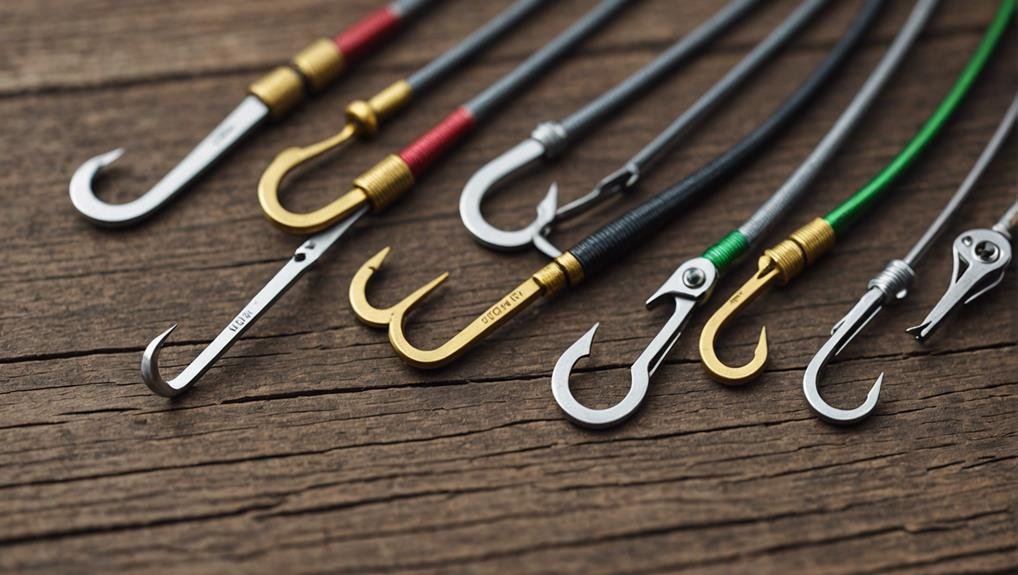
Selecting the correct hook size guarantees you match the fish species you’re targeting and improves your chances of a successful catch. Hook sizes can range from as tiny as size 32 to as large as 19/0. Understanding this numbering system is essential for making the right size selection. Generally, smaller numbers indicate larger hooks, so a size two hook is larger than a size 10.
When choosing a hook, consider the size of the fish’s mouth and the bait you’re using. For instance, if you’re targeting small fish like bluegill, a smaller hook, such as size 10 or 12, is ideal. Conversely, for larger fish like bass, you might opt for size 2 or 1/0 hooks. The bait also plays a critical role in your decision. Smaller baits require smaller hooks to make sure they can fit inside the fish’s mouth without being too conspicuous.
Different fishing scenarios demand different hook sizes. Whether fishing in freshwater or saltwater, always tailor your hook size to your specific fishing needs. By paying attention to these factors, you’ll make certain that your hook size is perfectly matched to the fish species and conditions you’re facing.
Freshwater Hook Sizes
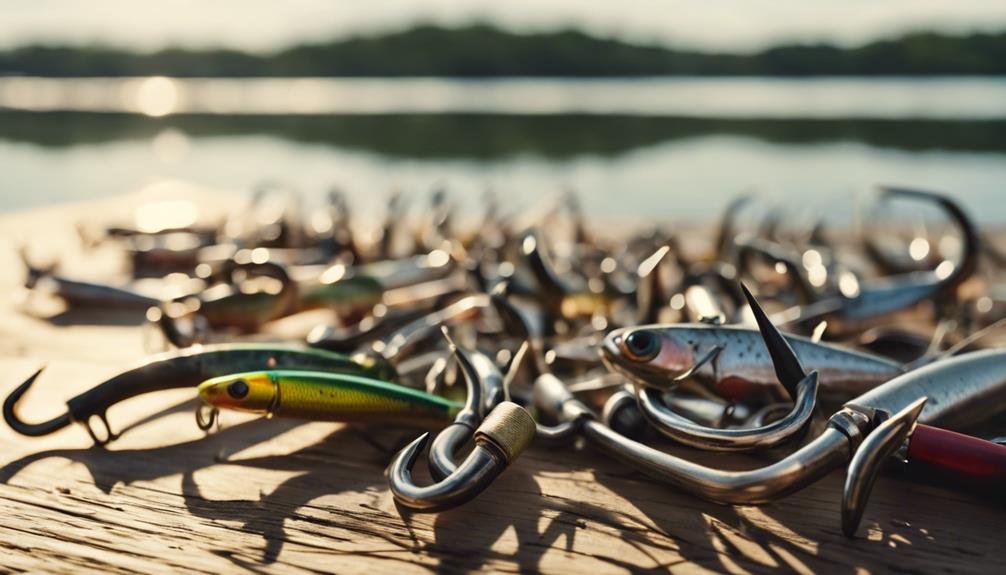
When fishing in freshwater, you’ll often find that hook sizes range from size 32 to size 1, catering to various species like panfish and trout. Smaller hooks in this size range are ideal for targeting these types of fish.
It’s important to understand the numbering system for freshwater hooks, as it allows you to select the perfect size for your target species.
The right hook size is essential for successful hook sets and landing your desired catch. For instance, smaller hooks are excellent for species of fish like trout, while larger hooks may be necessary for bass or catfish.
Here’s a quick breakdown to help you visualize:
- Size 32 to Size 1: Perfect for small species like panfish, bluegill and trout.
- Size 1/0 to Size 4/0: Effective for medium-sized fish like bass and walleye.
- Size 5/0 to Size 10/0: Suitable for larger species like catfish.
- Size 11/0 to 19/0: Typically used for large freshwater fish.
Saltwater Hook Sizes
Saltwater fishing hooks range from small sizes like 12 to massive sizes such as 19/0, each designed to handle different types of marine species. When you’re out saltwater fishing, selecting the right hook sizes is important. Smaller fish like snapper or mackerel might require a size 12 hook, while larger fish such as sharks or marlin need something more substantial, like an 8/0 to 19/0 hook.
Here’s a quick reference table for common saltwater fishing hooks:
| Hook Type | Ideal Fish Size | Common Use |
|---|---|---|
| Size 12 | Smaller fish | Bait fish, mackerel |
| Size 8/0 – 19/0 | Larger fish | Sharks, marlin |
| Circle Hooks | Various sizes | Catch and release |
Circle hooks are great for catch and release since they typically hook fish in the mouth, causing less harm. Aberdeen hooks, on the other hand, are excellent for using live bait because of their long shank. Always have a variety of specific hook sizes in your tackle box to adapt to different fishing conditions and species. Remember, using the right-sized hook not only increases your chances of a successful catch but also promotes a more sustainable fishing practice.
Hook Maintenance Tips
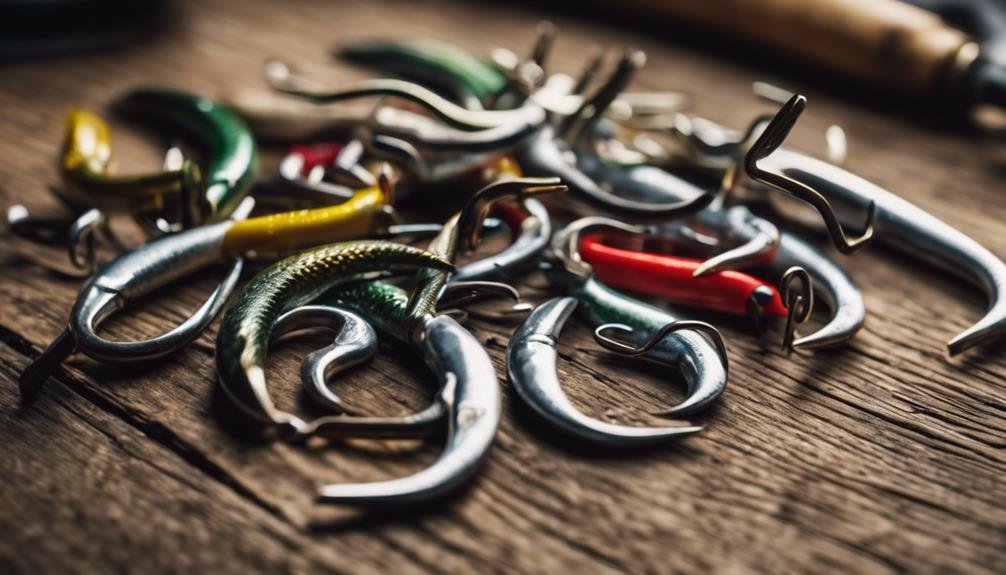
To keep your fishing hooks in top condition, regularly rinse them with fresh water after each use to prevent rust and corrosion. This simple step is essential for proper maintenance and will greatly extend the life of your hooks.
Additionally, sharpening your hooks with a fine-toothed mill file will maintain their sharpness, ensuring they perform well on your fishing trips.
Proper hook maintenance also involves organization. To prevent tangling and make your hooks easily accessible, organize them with safety pins in your tackle box. This method keeps everything neat and ready for action.
Remember, signs of dullness mean it’s time for hook replacement. Always check for sharpness using the thumbnail test—if the hook doesn’t catch, it’s too dull.
Here are some key hook maintenance tips:
- Rinse hooks with fresh water to prevent rusting and corrosion after each use.
- Sharpen hooks with a fine-toothed mill file to maintain their sharpness.
- Organize hooks using safety pins to keep them tangle-free in your tackle box.
- Check for dullness and replace hooks that fail the thumbnail sharpness test.
Conclusion
Understanding fishing hook sizes is crucial to a successful fishing trip. Always match the hook size to your target fish, considering their mouth size and bait.
Whether fishing in freshwater or saltwater, picking the right hook guarantees you’re ready for the conditions and boosts your chances of catching fish.
Don’t forget to maintain your hooks to keep them in top shape. With the right hook, you’re set for a great fishing experience!
